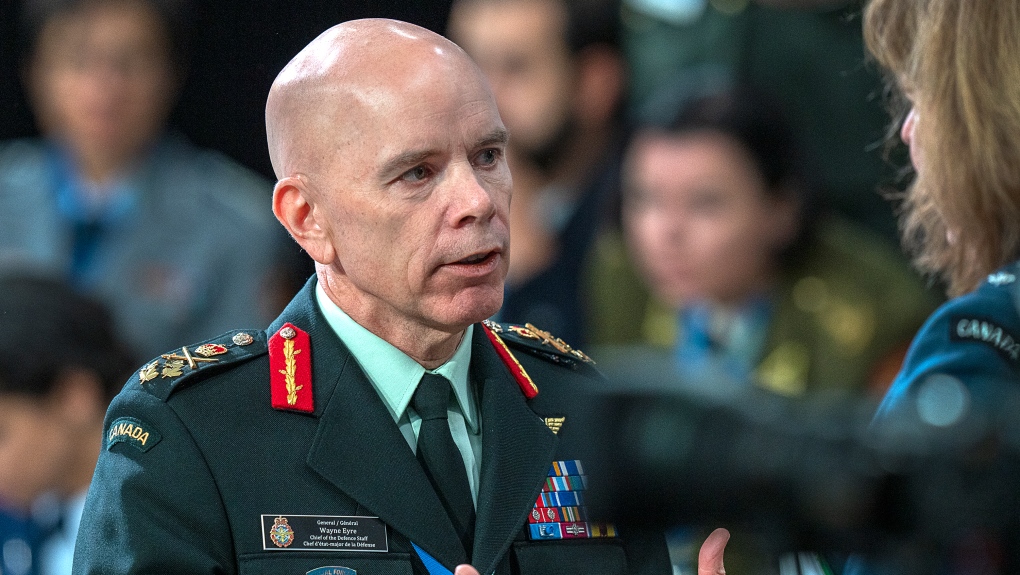I'll believe it when I see it.
You are using an out of date browser. It may not display this or other websites correctly.
You should upgrade or use an alternative browser.
You should upgrade or use an alternative browser.
Justin Trudeau hints at boosting Canada’s military spending
- Thread starter Maxman1
- Start date
- Reaction score
- 8,493
- Points
- 1,160
One of these is not like the other.
 www.nationaldefensemagazine.org
www.nationaldefensemagazine.org
Canada pays salaries and pensions.
Sweden buys hardware
Sweden has used its neutrality to its advantage. Its subsidization of the homegrown arms industry has resulted in innovations that have found homes in other armies, navies and air forces. Including the US @KevinB.
Even if Canada does sit in the attic of the arsenal of democracy it would benefit the US to encourage Canada to take on new interests.
You want help to hold North America - you have to make it worth our while. Just like you did with the Auto Pact for Norad and Free Trade for the North Warning System.
Military expenditure (% of GDP) in Canada was reported at 1.4151 % in 2020, according to the World Bank collection of development indicators, compiled from officially recognized sources. Canada - Military expenditure (% of GDP) - actual values, historical data, forecasts and projections were sourced from the World Bank on November of 2022.
Sweden moving from 1.4% of GDP to 2% - bringing the timeline forwards by 2 years to 2026.
WEB EXCLUSIVE: Sweden to Move Deadline Up for NATO’s 2% GDP Threshold Requirement
WEB EXCLUSIVE: Sweden to Move Deadline Up for NATO’s 2% GDP Threshold Requirement
Canada pays salaries and pensions.
Sweden buys hardware
assets include Patriot batteries, 100 jet fighters, electric submarines, naval surface combatants with low signatures and “good intelligence capabilities, particularly on Russia,” he said.
In addition, Sweden punches way above its weight when it comes to its defense industry. “There's no other country in the world of 10 million people who can produce submarines, fighter aircraft, advanced combat vehicles and artillery pieces,” he said. “I think we can bring things to the table when it comes to innovation and technology and partner up with corporations and new starts in the United States.”
The new Swedish government is also steadfastly supporting Ukraine’s fight against Russia with its ninth military aid package, totaling some $300 million, which is more than the previous eight aid packages combined, he said. The new funding will provide cold weather gear, equipment for the winter and air defense technology, he added.
Sweden elected a new government in September, and Jonson was sworn in as the new defense minister about a month later. The previous government had vowed to raise its defense spending in line with the NATO threshold by 2028. Jonson said Sweden currently spends about 1.4 percent of its GDP on defense. However, with the worsening security situation in Europe, the nation will move that goal up to 2026, he said.
“This is about solidarity with other allies. The Baltic nations are at about 2 percent. Poland is way over 2 percent, and Germany is on the track to 2 percent,” he said. All eight parties in the newly formed Swedish government support meeting the threshold, although half of them want to keep the original goal of 2028, he noted. “We can find bipartisan agreement on it,” he added.
As far as interoperability with NATO nations’ weapon systems, Jonson said Sweden doesn’t have far to go. Creating interoperable command, control and communications systems among the treaty’s allies has been a long-standing problem among members, as they go their separate ways when acquiring systems.
“We’re quite interoperable with NATO. We use Link 16 and Link 22 [radios]. Since we participate in many crisis management operations, we’re not so worried about the command structures as such. I think we're well on our way to integrate the internet since we've been participating in so many exercises,” he said.
Along with joining NATO, Sweden actively participates in exercises and keeps an eye on the Arctic region, where Russia has been continuing to aggressively advance its interests, he said. The war in Ukraine has not diminished Russia’s activity in the region, he noted.
And China has declared itself a “near-Arctic” nation and is increasing its activity there even though no other nation recognizes it as such, Jonson added. “They've been increasing their presence there as well, and we're cognizant about that,” he said. Sweden published a new Arctic strategy two years ago, which is “more precise” when it comes to some of the threats, risks and vulnerabilities there, especially with increased Russian presence, he said.
“There's going to be more focus on the Arctic in the future,” Jonson said.
Sweden has used its neutrality to its advantage. Its subsidization of the homegrown arms industry has resulted in innovations that have found homes in other armies, navies and air forces. Including the US @KevinB.
Even if Canada does sit in the attic of the arsenal of democracy it would benefit the US to encourage Canada to take on new interests.
You want help to hold North America - you have to make it worth our while. Just like you did with the Auto Pact for Norad and Free Trade for the North Warning System.
MilEME09
Army.ca Veteran
- Reaction score
- 2,872
- Points
- 1,210
CDS essentially admits we are not able to under take any large scale operations, we are too under staffed and under equipped.

 www.ctvnews.ca
www.ctvnews.ca

Canadian military would be 'challenged' to launch a large scale operation: chief of the defence staff
Canada’s military forces are 'ready' to meet their commitments should Russia's war in Ukraine spread to NATO countries, but it would be a 'challenge' to launch a larger scale operation in the long term, with ongoing personnel and equipment shortages, according to Chief of the Defence Staff Gen...
I admire his courage to say these things when his boss is basically telling the voting public that ‘this is fine.’CDS essentially admits we are not able to under take any large scale operations, we are too under staffed and under equipped.

Canadian military would be 'challenged' to launch a large scale operation: chief of the defence staff
Canada’s military forces are 'ready' to meet their commitments should Russia's war in Ukraine spread to NATO countries, but it would be a 'challenge' to launch a larger scale operation in the long term, with ongoing personnel and equipment shortages, according to Chief of the Defence Staff Gen...www.ctvnews.ca
daftandbarmy
Army.ca Dinosaur
- Reaction score
- 33,729
- Points
- 1,160
CDS essentially admits we are not able to under take any large scale operations, we are too under staffed and under equipped.

Canadian military would be 'challenged' to launch a large scale operation: chief of the defence staff
Canada’s military forces are 'ready' to meet their commitments should Russia's war in Ukraine spread to NATO countries, but it would be a 'challenge' to launch a larger scale operation in the long term, with ongoing personnel and equipment shortages, according to Chief of the Defence Staff Gen...www.ctvnews.ca
Good of him to save the government the trouble... a real servant leader move

Quirky
Army.ca Veteran
- Reaction score
- 3,800
- Points
- 1,260
I admire his courage to say these things when his boss is basically telling the voting public that ‘this is fine.’
Canadians: “we have a military? hahaha”….. *go back to scrolling on their phones.
- Reaction score
- 7,666
- Points
- 1,310
CDS essentially admits we are not able to under take any large scale operations, we are too under staffed and under equipped.

Canadian military would be 'challenged' to launch a large scale operation: chief of the defence staff
Canada’s military forces are 'ready' to meet their commitments should Russia's war in Ukraine spread to NATO countries, but it would be a 'challenge' to launch a larger scale operation in the long term, with ongoing personnel and equipment shortages, according to Chief of the Defence Staff Gen...www.ctvnews.ca
Shame. I really liked him...
Minister Anand at the moment:
Attachments
MilEME09
Army.ca Veteran
- Reaction score
- 2,872
- Points
- 1,210
You know things are when the ARes gets asked to supply 15% of a tour on 90 days notice, and people aren't selected until 45 days notice
daftandbarmy
Army.ca Dinosaur
- Reaction score
- 33,729
- Points
- 1,160
You know things are when the ARes gets asked to supply 15% of a tour on 90 days notice, and people aren't selected until 45 days notice
And then half DAG Red at the last minute for dental?
- Reaction score
- 1,784
- Points
- 1,060
Forgetting the Navy and Airforce for a second what is the Army doing that is stressing it so much? A peacetime deployment to Latvia? At what point is it the CAF's and CDS's responsibility to be able to deliver? Quite frankly the CAF's dont seem like value for money. Is it because the funding is never enough to get an appreciable return or is it because of the choices made by successive governments and CDS's?CDS essentially admits we are not able to under take any large scale operations, we are too under staffed and under equipped.

Canadian military would be 'challenged' to launch a large scale operation: chief of the defence staff
Canada’s military forces are 'ready' to meet their commitments should Russia's war in Ukraine spread to NATO countries, but it would be a 'challenge' to launch a larger scale operation in the long term, with ongoing personnel and equipment shortages, according to Chief of the Defence Staff Gen...www.ctvnews.ca
daftandbarmy
Army.ca Dinosaur
- Reaction score
- 33,729
- Points
- 1,160
Forgetting the Navy and Airforce for a second what is the Army doing that is stressing it so much? A peacetime deployment to Latvia? At what point is it the CAF's and CDS's responsibility to be able to deliver? Quite frankly the CAF's dont seem like value for money. Is it because the funding is never enough to get an appreciable return or is it because of the choices made by successive governments and CDS's?
Holy crap...
"Eyre said his number one priority is getting Canada’s armed forces up to full strength, with an attrition rate of 9.3 per cent between both regular and reserve forces, up from 6.9 per cent last year. The Canadian Armed Forces Retention Strategy was released just last month."
- Reaction score
- 1,784
- Points
- 1,060
Yeah that seems like a bad number. its been known that recruitment and retention have been a problem for a long time. Its been talked about on this site. I mean 9.3% is going to be an insurmountable problem if not fixed quickly. Can the CAF do that? It also doesnt help when people wait 2 years to join up.Holy crap...
"Eyre said his number one priority is getting Canada’s armed forces up to full strength, with an attrition rate of 9.3 per cent between both regular and reserve forces, up from 6.9 per cent last year. The Canadian Armed Forces Retention Strategy was released just last month."
The 9.3% attrition this is from people not reupping or is the CAF losing 9.3% a year of total personel?
- Reaction score
- 20,017
- Points
- 1,280
I would guess the latter.The 9.3% attrition this is from people not reupping or is the CAF losing 9.3% a year of total personel?
- Reaction score
- 1,784
- Points
- 1,060
Thats a lot for a big institution. Sometimes the problem has to get really big before anyone pays attention I guess. For any small business Ive been involved with we 10% attrition would have been considered a good year. But I have a feeling the CAF are losing the people that actually do the work and are necessary to everyday function. Funny how not that long ago we were talking about some sort of mandatory service, maybe we need it to save the CAF's from itself as much as to provide career opportunities for people
- Reaction score
- 6,973
- Points
- 1,140
The last thing the CAF needs is people forced to be there... Want to see your good people leave? Make them work alongside people who don't want to be there, and don't care about the job.Thats a lot for a big institution. Sometimes the problem has to get really big before anyone pays attention I guess. For any small business Ive been involved with we 10% attrition would have been considered a good year. But I have a feeling the CAF are losing the people that actually do the work and are necessary to everyday function. Funny how not that long ago we were talking about some sort of mandatory service, maybe we need it to save the CAF's from itself as much as to provide career opportunities for people
- Reaction score
- 10,444
- Points
- 1,360
Holy crap...
"Eyre said his number one priority is getting Canada’s armed forces up to full strength, with an attrition rate of 9.3 per cent between both regular and reserve forces, up from 6.9 per cent last year. The Canadian Armed Forces Retention Strategy was released just last month."
The CAF has a retention strategy?
I thought they were saying as little as a few months ago: "what retention problem?"
- Reaction score
- 20,017
- Points
- 1,280
I wonder what the "standard" level of attrition is for the CAF? It can't be zero because people do retire.Thats a lot for a big institution. Sometimes the problem has to get really big before anyone pays attention I guess.
The strategy is to hope that a recession brings people back. The problem is that this recession will be different because there isn’t a lack of available jobs.The CAF has a retention strategy?
I thought they were saying as little as a few months ago: "what retention problem?"
- Reaction score
- 7,666
- Points
- 1,310
The reason for why there is that much attrition is 2 fold:
-the largest cohort of generations since the Second World War is starting to retire. Their "replacements" weren't hired due to the FRP in the 90s. Massive gaps up in the senior side of the house for both the Snr NCO/WO cadre as well as the Officer corps.
And
-"doing more with less" for 40 odd years means our equipment is broken, harder to maintain, and in some cases; divested to the point where you're not actually doing the job you saw in the cool recruiting video. Couple that with the gradual the "doing more with less" reduction in traditional supports like housing, social clubs, messes, infrastructure; while downloading it onto the member to provide, while refusing to budge on revizing the Compensation and Benefits structure to attract and retain talent.
Put those two things together and your "CAF Offer TM" isn't nearly as awesome as you make it out to be; both for recruiting and retention.
-the largest cohort of generations since the Second World War is starting to retire. Their "replacements" weren't hired due to the FRP in the 90s. Massive gaps up in the senior side of the house for both the Snr NCO/WO cadre as well as the Officer corps.
And
-"doing more with less" for 40 odd years means our equipment is broken, harder to maintain, and in some cases; divested to the point where you're not actually doing the job you saw in the cool recruiting video. Couple that with the gradual the "doing more with less" reduction in traditional supports like housing, social clubs, messes, infrastructure; while downloading it onto the member to provide, while refusing to budge on revizing the Compensation and Benefits structure to attract and retain talent.
Put those two things together and your "CAF Offer TM" isn't nearly as awesome as you make it out to be; both for recruiting and retention.
FJAG
Army.ca Legend
- Reaction score
- 14,269
- Points
- 1,160
From a CAF website:I wonder what the "standard" level of attrition is for the CAF? It can't be zero because people do retire.
3.1 Attrition in the CAF
The average rate of attrition from the CAF (Reg Force and P Res) is generally between 8% and 9%. This rate compares favourably with the Canadian labour market, including both the private (10.2%) and public sectors (4.7%) (Coburn & Cowan, 2019).
Similar threads
- Article
- Replies
- 618
- Views
- 238K
- Replies
- 28
- Views
- 13K
- Replies
- 3
- Views
- 4K
- Replies
- 34
- Views
- 13K
- Replies
- 294
- Views
- 57K




